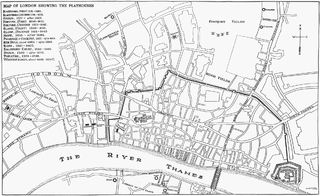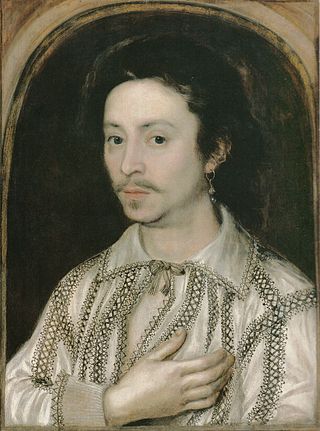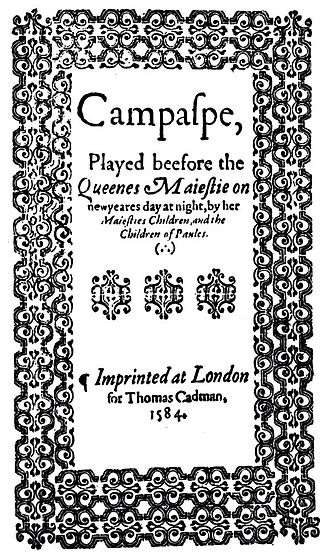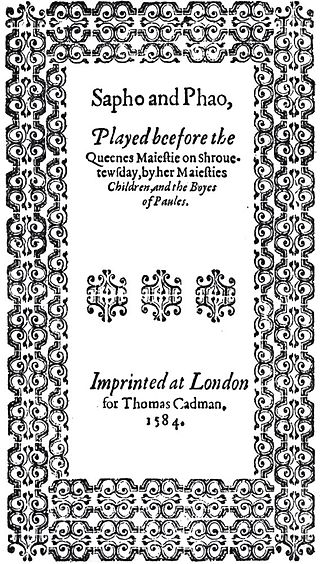Related Research Articles

English Renaissance theatre, also known as Renaissance English theatre and Elizabethan theatre, refers to the theatre of England between 1558 and 1642.

John Lyly was an English writer, dramatist of the University Wits, courtier, and parliamentarian. He was best known during his lifetime for his two books Euphues: The Anatomy of Wit (1578) and its sequel Euphues and His England (1580), but perhaps best remembered now for his plays. Lyly's distinctive and much imitated literary style, named after the title character of his two books, is known as euphuism.
The King's Men is the acting company to which William Shakespeare (1564–1616) belonged for most of his career. Formerly known as the Lord Chamberlain's Men during the reign of Queen Elizabeth I, they became the King's Men in 1603 when King James I ascended the throne and became the company's patron.
John Heminges was an actor in the King's Men, the playing company for which William Shakespeare wrote. Along with Henry Condell, he was an editor of the First Folio, the collected plays of Shakespeare, published in 1623. He was also the financial manager for the King's Men.
City comedy, also known as citizen comedy, is a genre of comedy in the English early modern theatre.

Blackfriars Theatre was the name given to two separate theatres located in the former Blackfriars Dominican priory in the City of London during the Renaissance. The first theatre began as a venue for the Children of the Chapel Royal, child actors associated with the Queen's chapel choirs, and who from 1576 to 1584 staged plays in the vast hall of the former monastery. The second theatre dates from the purchase of the upper part of the priory and another building by James Burbage in 1596, which included the Parliament Chamber on the upper floor that was converted into the playhouse. The Children of the Chapel played in the theatre beginning in the autumn of 1600 until the King's Men took over in 1608. They successfully used it as their winter playhouse until all the theatres were closed in 1642 when the English Civil War began. In 1666, the entire area was destroyed in the Great Fire of London.

Nathan Field was an English dramatist and actor.
In Renaissance-era London, playing company was the usual term for a company of actors. These companies were organised around a group of ten or so shareholders, who performed in the plays but were also responsible for management. The sharers employed "hired men" – that is, the minor actors and the workers behind the scenes. The major companies were based at specific theatres in London; the most successful of them, William Shakespeare's company the King's Men, had the open-air Globe Theatre for summer seasons and the enclosed Blackfriars Theatre in the winters. The Admiral's Men occupied the Rose Theatre in the 1590s, and the Fortune Theatre in the early 17th century.

A boy player was a male child or teenager who performed in Medieval and English Renaissance playing companies. Some boy players worked for adult companies and performed the female roles, since women did not perform on the English stage during this period. Others worked for children's companies in which all roles, not just the female ones, were played by boys.
The Children of the Chapel are the boys with unbroken voices, choristers, who form part of the Chapel Royal, the body of singers and priests serving the spiritual needs of their sovereign wherever they were called upon to do so. They were overseen by the Master of the Children of the Chapel Royal.
Beeston's Boys was the popular and colloquial name of The King and Queen's Young Company, a troupe of boy actors of the Caroline period, active mainly in the years 1637–1642.
Stephen Hammerton was a boy player or child actor in English Renaissance theatre, one of the young performers who specialized in female roles in the period before women appeared on the stage. His case illuminates the conditions of boy actors in this era.
The King's Revels Children or Children of the King's Revels were a troupe of actors, or playing company, in Jacobean era London, active in the 1607-9 period. They were part of a fashion for child actors that peaked in the first decade of the seventeenth century, with the Children of Paul's and the Children of the Chapel.
The Conspiracy and Tragedy of Charles, Duke of Byron, Marshall of France is a Jacobean tragedy by George Chapman, a two-part play or double play first performed and published in 1608. It tells the story of Charles de Gontaut, duc de Biron, executed for treason in 1602.
Cynthia's Revels, or The Fountain of Self-Love is a late Elizabethan stage play, a satire written by Ben Jonson. The play was one element in the Poetomachia or War of the Theatres between Jonson and rival playwrights John Marston and Thomas Dekker.

Campaspe is an Elizabethan era stage play, a comedy by John Lyly based on the life of Campaspe. Widely considered Lyly's earliest drama, Campaspe was an influence and a precedent for much that followed in English Renaissance drama.

Sapho and Phao is an Elizabethan era stage play, a comedy written by John Lyly. One of Lyly's earliest dramas, it was likely the first that the playwright devoted to the allegorical idealisation of Queen Elizabeth I that became the predominating feature of Lyly's dramatic canon.
John Underwood was an early 17th-century actor, a member of the King's Men, the theatrics company of William Shakespeare.
Richard Gunnell was an actor, playwright, and theatre manager in Jacobean and Caroline era London. He is best remembered for his role in the founding of the Salisbury Court Theatre.
Henry Evans was the Welsh scrivener and theatrical producer primarily responsible for organising and co-ordinating the activities of the Children of the Chapel and the Children of Paul's at Blackfriars Theatre for a short period in 1583–84. He later led a consortium of investors who leased the theatre during a much longer second phase, after the property was revived by Richard Burbage and Cuthbert Burbage.
References
- Chambers, E. K. The Elizabethan Stage. 4 Volumes, Oxford, Clarendon Press, 1923.
- Gurr, Andrew. The Shakespearean Stage 1574–1642. Cambridge, UK, Cambridge University Press, 1992. p. 33-54.
- Halliday, F. E. A Shakespeare Companion 1564–1964. Baltimore, Penguin, 1964.
- Hentschell, Roze F. "'Our Children Made Enterluders': Choristers, Actors, and Students in St Paul's Cathedral Precinct." Early Theatre, vol. 19,
no. 1, 2016, p. 179–196. EBSCOhost, https://dx.doi.org/10.12745/et.19.2.2837.
- Knutson, Roslyn Lander. Playing Companies and Commerce in Shakespeare's Time, Cambridge University Press, 2001, p. 84.
- Shapiro, Michael. "Boy Companies and Private Theaters." A Companion to Renaissance Drama, edited by Arthur F. Kinney, Blackwell Publishing Ltd,
2004, p. 315.